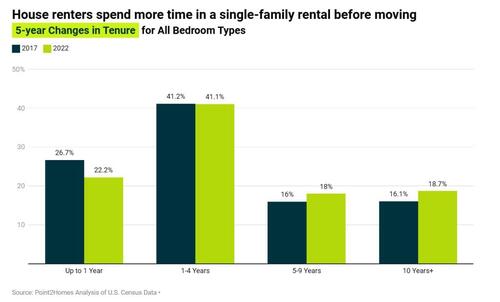
Authored by Mike Shedlock via MishTalk.com,
Soaring home prices keep many on the sidelines. Renters in need of more space and privacy are making house rentals their long-term homes.
The Houses That Renters Never Want to Leave
Point2Homes discusses The Houses That Renters Never Want to Leave
-
Moving after less than 1 year is becoming less appealing: Compared to 2017, the number of house renters who spend less than 12 months in a home before moving fell 4.5% and decreased in 70 of the 75 metros we reviewed.
-
The shares of renters who move after less than 12 months dropped the most in Bakersfield, CA (-12.4%); followed by Tucson, AZ (-10%); and Omaha-Council Bluffs, NE-IA (-10%).
-
Long-term renting is gaining ground: More and more house renters are slowly but surely making the single-family home rental they currently occupy into what may be their forever home.
-
Long-term and very long-term renters in California’s Riverside-San Bernardino-Ontario and Oxnard-Thousand Oaks-Ventura are leading the trend as their shares increased by more than 7% in the last 5 years.
-
Space is no longer a preference, but a necessity: Nearly half of single-family renters (47%) gravitate toward spacious three-bedroom homes, making them the top pick for those seeking extra room to rent, according to the latest Census data on house renter tenure.
House Renters Spend More Time Before Moving
Of the 45,646,491 renter households in the country, 14,227,371 are single-family renter households. And they’re increasingly going the distance: According to Point2Homes‘ most recent analysis of Census data, renters who spend five to nine and 10+ years in their rental before moving increased by 2 and 2.7 percentage points, respectively. On the other hand, the number of renters who move after just 12 months fell -4.5 percentage points compared to five years ago.
High cost of living, supply scarcity, growing home prices and high mortgage rates make it impossible — or at the very least extremely difficult — for renters to start saving for a down payment, thereby keeping them renting for longer.
But it’s not just increasing home prices that are keeping renters put. Rental prices have also shot up in recent years, discouraging renters from moving, as that would require taking on a likely higher lease.
That’s obvious in the nation’s 75 largest metros: Throughout the last five years, the share of renters who move after less than 12 months decreased in all but four metros. What’s more, three metros are posting double-digit drops in the shares of short-tenure renters: In Bakersfield, CA (-12.4%); Tucson, AZ (-10%); and Omaha, NE (-10%), renters really seem to be rethinking their strategy and are staying put.
Census data is woefully lagging so we need to be a bit careful on such stale data.
But who really likes to move?
Based on falling prices of new leases, many claim “rent is falling”. But most people don’t move.
And the fewer people who do move, the more sticky existing rent prices are.
The Point of Renting a House
If Gen Z renters, young, single Millennials and downsizing Baby Boomers can make do with smaller homes, they’re not the majority. Most renters of single-family homes prefer the larger, three-bedroom houses for rent: Nearly half (47%) of all house renters opted for a roomy three-bedroom, whereas less than 10% went for a one-bedroom house for rent.
Net numbers are equally telling: Nearly 7 million renters live in three-bedroom houses, followed at a distance by the 4 million who choose a two-bedroom rental.
That’s because single-family homes for rent cater to a very specific demographic — renters who are kept on the sidelines, unable to buy a home big enough for their changing needs.
Where Do Renters Live?
-
In 2023, 38% of renters in the US lived in apartment buildings with five or more units.
-
Another 17% of renters lived in buildings with two to four units.
-
The remaining 41% of renters lived in single-family homes.
-
5% of renters lived in mobile homes.
The above is an AI response to my question. Those who live in a big city apartment may be surprised that only 38 percent live in big apartment buildings.
People under the age of 30 comprised the largest share of renters in the U.S. in 2022. Almost half of the population that lives in a rental apartment fell in this age group.
According to research published earlier this year by John Burns Research and Consulting, remote work lives on: “Despite return-to-office policies, remote work remains about four times more prevalent than pre-COVID. […] the resulting outflow to more outlying areas is akin to the massive shifts caused by the car revolution of the 1950s and 1960s that opened up the first ring of suburbia.”
There’s much more in the article for those interested in renting and rental trends.
The CPI is Wednesday. The Bloomberg consensus is another 0.3 percent. The Fed would not consider that progress.
I will closely be watching shelter.
Authored by Mike Shedlock via MishTalk.com,
Soaring home prices keep many on the sidelines. Renters in need of more space and privacy are making house rentals their long-term homes.
The Houses That Renters Never Want to Leave
Point2Homes discusses The Houses That Renters Never Want to Leave
-
Moving after less than 1 year is becoming less appealing: Compared to 2017, the number of house renters who spend less than 12 months in a home before moving fell 4.5% and decreased in 70 of the 75 metros we reviewed.
-
The shares of renters who move after less than 12 months dropped the most in Bakersfield, CA (-12.4%); followed by Tucson, AZ (-10%); and Omaha-Council Bluffs, NE-IA (-10%).
-
Long-term renting is gaining ground: More and more house renters are slowly but surely making the single-family home rental they currently occupy into what may be their forever home.
-
Long-term and very long-term renters in California’s Riverside-San Bernardino-Ontario and Oxnard-Thousand Oaks-Ventura are leading the trend as their shares increased by more than 7% in the last 5 years.
-
Space is no longer a preference, but a necessity: Nearly half of single-family renters (47%) gravitate toward spacious three-bedroom homes, making them the top pick for those seeking extra room to rent, according to the latest Census data on house renter tenure.
House Renters Spend More Time Before Moving
Of the 45,646,491 renter households in the country, 14,227,371 are single-family renter households. And they’re increasingly going the distance: According to Point2Homes‘ most recent analysis of Census data, renters who spend five to nine and 10+ years in their rental before moving increased by 2 and 2.7 percentage points, respectively. On the other hand, the number of renters who move after just 12 months fell -4.5 percentage points compared to five years ago.
High cost of living, supply scarcity, growing home prices and high mortgage rates make it impossible — or at the very least extremely difficult — for renters to start saving for a down payment, thereby keeping them renting for longer.
But it’s not just increasing home prices that are keeping renters put. Rental prices have also shot up in recent years, discouraging renters from moving, as that would require taking on a likely higher lease.
That’s obvious in the nation’s 75 largest metros: Throughout the last five years, the share of renters who move after less than 12 months decreased in all but four metros. What’s more, three metros are posting double-digit drops in the shares of short-tenure renters: In Bakersfield, CA (-12.4%); Tucson, AZ (-10%); and Omaha, NE (-10%), renters really seem to be rethinking their strategy and are staying put.
Census data is woefully lagging so we need to be a bit careful on such stale data.
But who really likes to move?
Based on falling prices of new leases, many claim “rent is falling”. But most people don’t move.
And the fewer people who do move, the more sticky existing rent prices are.
The Point of Renting a House
If Gen Z renters, young, single Millennials and downsizing Baby Boomers can make do with smaller homes, they’re not the majority. Most renters of single-family homes prefer the larger, three-bedroom houses for rent: Nearly half (47%) of all house renters opted for a roomy three-bedroom, whereas less than 10% went for a one-bedroom house for rent.
Net numbers are equally telling: Nearly 7 million renters live in three-bedroom houses, followed at a distance by the 4 million who choose a two-bedroom rental.
That’s because single-family homes for rent cater to a very specific demographic — renters who are kept on the sidelines, unable to buy a home big enough for their changing needs.
Where Do Renters Live?
-
In 2023, 38% of renters in the US lived in apartment buildings with five or more units.
-
Another 17% of renters lived in buildings with two to four units.
-
The remaining 41% of renters lived in single-family homes.
-
5% of renters lived in mobile homes.
The above is an AI response to my question. Those who live in a big city apartment may be surprised that only 38 percent live in big apartment buildings.
People under the age of 30 comprised the largest share of renters in the U.S. in 2022. Almost half of the population that lives in a rental apartment fell in this age group.
According to research published earlier this year by John Burns Research and Consulting, remote work lives on: “Despite return-to-office policies, remote work remains about four times more prevalent than pre-COVID. […] the resulting outflow to more outlying areas is akin to the massive shifts caused by the car revolution of the 1950s and 1960s that opened up the first ring of suburbia.”
There’s much more in the article for those interested in renting and rental trends.
The CPI is Wednesday. The Bloomberg consensus is another 0.3 percent. The Fed would not consider that progress.
I will closely be watching shelter.
Loading…








